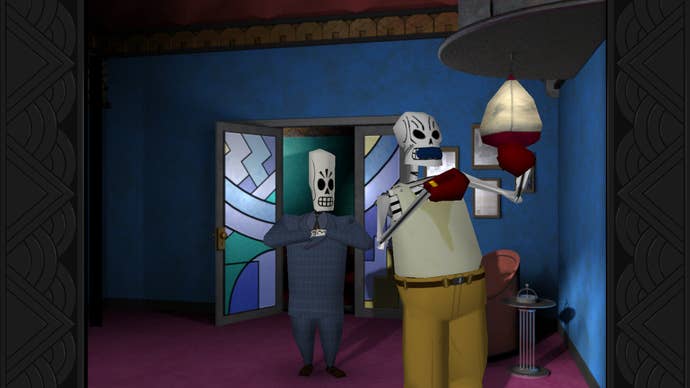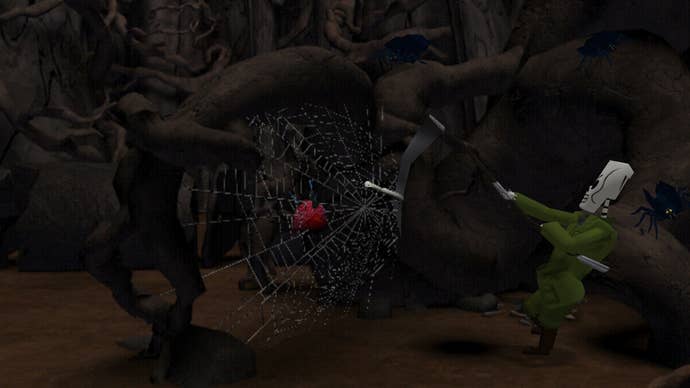Grim Fandango Remastered PS4 Review: A Bone to Pick
Tim Schafer's 1998 tribute to film noir spins a gripping tale, but its unfriendly puzzles will have many calling it quits before the final curtain.
This article first appeared on USgamer, a partner publication of VG247. Some content, such as this article, has been migrated to VG247 for posterity after USgamer's closure - but it has not been edited or further vetted by the VG247 team.
With classic PC adventure games—especially those created by the now-defunct LucasArts—the question posed to players most often is "How?" Typically, these experiences provide a clear directive, pocketfuls of items, and a reactive world to use them on in order to achieve a list of defined goals.
With Grim Fandango, though, I was asked the question "Why?" more often than not. And when I found myself unable to provide a compelling answer, that's where my troubles began.
Of course, I'm no stranger to the tropes of this ancient genre. Their puzzle solutions may seem absolutely baffling if you take them at face value, but, at their very best, adventure games craft an airtight sense of internal logic that makes complete sense given the situation at hand. But, for whatever reason, Grim Fandango's design feels markedly different than the LucasArts adventures preceding it: Instead of feeling satisfied by outsmarting the designers, solving a puzzle in Grim typically comes with an oddly empty feeling, paired with a muttering along the lines of, "That's what they wanted me to do?" And since my initial and only memories of the game date back to those Caveman Times of 1999, you better believe my living room was a cranky place to be during the course of Grim Fandango Remastered's 15 hours.

For the most part, Grim Fandango focuses on providing large, interconnected areas that offer a handful of puzzles to solve—ostensibly, to provide other things to work on if players find themselves confused into submission by a particularly tricky roadblock. The real issue here, though, is that many of these puzzles can be approached in any order, so I often found myself stumbling into the second half of a problem before encountering the first half. Without giving any solutions away, I ran into a character with a metal detector, and protagonist Manny seemed absolutely fixated on borrowing this device—20 minutes later, I experienced the event that made this item a necessity. Multiple times throughout my playthrough, Manny had an inexplicable desire or drive for something or someone, which would only be given meaning later via an event or scene I should have encountered first. By the end of Grim, I began to believe Manny was secretly an adventure game developer in his previous life.
Another flaw of this open design can be found in how often Grim removes vital information about active puzzles from its world. When exploring new areas, I would typically consume all the dialogue of characters I met, to the point where Manny didn't have anything else to say to them. Problems began to arise when I didn't recognize the relevance of certain information that could easily be passed off as irrelevant flavor text without the proper context—it got to the point where I felt compelled to write anything down that seemed like a clue, if only because I wouldn't be able to access that particular chunk of dialogue ever again. (By the end, my Google Doc for Grim Fandango notes came in at around 2000 words.)
The pre-rendered backgrounds don't do Grim's puzzles any favors, either. While they're impressively rendered—especially for 1998—and give the world a consistent visual design, even LucasArts can't avoid the expected problems with this format. Many puzzles stopped me in my tracks because Grim didn't make it obvious enough that a path or doorway led to a new environment, and many important areas of interest simply escaped me because I didn't notice the slight turn of Manny's head indicating I could interact with them. Grim also contains an alarming amount of timing-based puzzles that don't work all that well given the limitations of pre-rendered backgrounds: On quite a few occasions, I thought I had the wrong solution to a puzzle, only to later learn that I didn't have Manny in juuust the right place.
With all of its design issues, it's strange to think Grim could possibly salvage the experience with its story—yet, amazingly enough, it does. While the plot loses a little oomph if you've seen your share of Schafer's inspirations—essentially, Grim is a pastiche of Casablanca, The Big Sleep, and The Maltese Falcon—The Land of the Dead makes for an unforgettable backdrop, especially with LucasArts' usual injection of the mundane into a fantastical setting. And Manny remains one of the best video game protagonists I've had the pleasure of playing as, mostly because of Grim's scope: Since we follow him throughout a four-year journey, we see Manny encounter ups, downs, and everything in between. If anything, the puzzles that didn't serve to push the story forward annoyed me, because I honestly had a lot invested in Manny's journey.

Double Fine's work on this remastered version doesn't provide a notably different experience from the original, but the minor changes are still appreciated. Grim Fandango's cast of characters still retain their incredibly low polygon count, but the new lighting and shading system (which can be turned on and off at will with the click of the analog stick) makes them much more presentable, even if it calls a bit more attention to their clumsy, segmented construction. The biggest addition, by far, comes in the form of developer commentary that's much more thorough than the paltry offerings of the Monkey Island 1 and 2 Special Editions: each screen contains at least one instance of commentary (activated by pressing the L1 button), and these brief discussions rarely spoil any future events—at the very worst, Schafer and the rest only clued me into some minor details about two or three puzzles. It definitely adds a lot to the experience, especially if you're interested in knowing about LucasArts' corporate culture at the time.
Given the sterling reputation of Grim Fandango, it hurts to feel so underwhelmed by the experience—especially as a fan of adventure games. But, by the halfway point, I couldn't help but keep a FAQ close at hand, if only to maintain my patience. It certainly doesn't help that Grim Remastered is an extremely buggy experience: The original game existed as a patchwork of late '90s LucasArts technology, which may explain why this 2015 version crashed and froze so often for me. Still, if you can stomach its flaws, it's nearly impossible not to fall in love with the world of Grim Fandango—so long as you remember there's no shame in looking up a solution.
VisualsGrim's 1998 polygonal graphics certainly don't hold up in 2015, but the Remastered version certainly makes them more presentable.
SoundThe mix of jazz and swing gives Grim a lot of spirit, and the improved (orchestrated) tracks certainly help a lot.
InterfaceFreed from tank controls, Grim feels like a much more modern experience.
Lasting AppealIt's an adventure game, so it's a one-and-done kind of deal. And while the puzzles may fade from your mind, Manny's story should stick with you for years to come.
ConclusionGrim's lack of availability may have helped it achieve sainthood, so its baffling puzzles may comes as a shock to many. If you can tolerate frustration, though, Schafer's final LucasArts production provides one of the best adventure game stories ever crafted—just be sure to keep an FAQ nearby.








